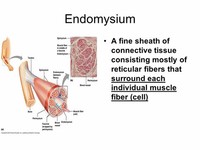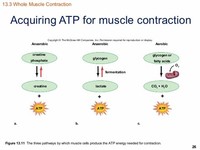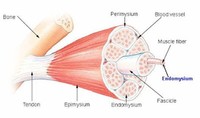Facts about Muscle

A non-invasive elastography technique that measures muscle noise is undergoing experimentation to provide a way of monitoring neuromuscular disease.

A muscle fiber, also technically known as a myocyte, is a single cell of a muscle.

Striated muscle (cardiac and skeletal) contracts and relaxes in short, intense bursts, whereas smooth muscle sustains longer or even near-permanent contractions.

Endomysium is the fine sheath of tissue that surrounds each single muscle fiber.

On the other hand, cardiac muscle shares many properties with smooth muscle, including being controlled by the autonomic nervous system and spontaneous (automatic) contractions.

Cardiac and smooth muscle contractions are stimulated by internal pacemaker cells that regularly contract, and propogate contractions to other muscle cells with which they are in contact.

Muscle fibers can be very short, such as 1 millimeter, to very long, such as 30 centimeters (11.8 inches).

All skeletal muscle and many smooth muscle contractions are facilitated by the neurotransmitter acetylcholine.

Cardiac muscle is anatomically different in that the muscle fibers are typically branched like a tree branch, and connect to other cardiac muscle fibers through intercalcated discs, and form the appearance of a syncytium.

Muscle (from Latin musculus, "little mouse"), the contractile tissue of animal bodies, comprises fibers specialized to contract and effect bodily movement.

The efficiency of human muscle has been measured (in the context of rowing and cycling) at 14 to 27 percent.

All muscle cells produce ATP molecules, which are used to power the movement of the myosin heads.

Cardiac and skeletal muscle are similar in that both appear to be "striated" in that they contain sarcomeres.

A sarcomere is the basic functional unit of a muscle's cross-striated myofibril, the alternating bundles of filaments composed primarily of actin or myosin.

People with high overall musculation and balanced muscle type percentage may be suited to engage in sports such as rugby or boxing.

Much muscle contraction occurs without conscious thought and is necessary for survival, like the contraction of the heart, or peristalsis (which pushes food through the digestive system).

During aging, there is a gradual decrease in the ability to maintain skeletal muscle function and mass, known as sarcopenia.

Delayed onset muscle soreness is the pain or discomfort often felt 24 to 76 hours after exercising and subsides generally within two to three days.

Muscle cells also contain globules of fat, which are used for energy during aerobic exercise.

Voluntary muscle contraction is used to move the body, and can be finely controlled, like movements of the eye, or gross movements like the quadriceps muscle of the thigh.

Once thought to be caused by lactic acid buildup, a more recent theory is that it is caused by tiny tears in the muscle fibers caused by eccentric contraction, or unaccustomed training levels.

Other syndromes or conditions that can induce skeletal muscle atrophy are congestive heart disease and some diseases of the liver.

Exercise is often recommended as a means of improving motor skills, fitness, muscle and bone strength, and joint function.

Contrary to popular belief, the number of muscle fibers cannot be increased through exercise; instead the muscle cells simply get bigger.

The sardana is the most characteristic Catalonian popular dance; other groups also practice Ball de bastons, moixiganga, or jota in the southern part.

Cardiac muscle on the other hand, can readily consume any of the three macronutrients (protein, glucose, and fat) without a "warm up" period and always extracts the maximum ATP yield from any molecule involved.

Muscle fibers, perhaps 10 to 100 or more, are bound together by perimysium, a connective tissue, into bundles called fascicles.

The sarcomeres are what give skeletal and cardiac muscles their striated appearance.

Humans are genetically predisposed with a larger percentage of one type of muscle group over another.

The sound produced by a muscle comes from the shortening of actomyosin filaments along the axis of the muscle.

Along the way, feedback loops such as that of the extrapyramidal system contribute signals to influence muscle tone and response.

During contraction, the muscle shortens along its longitudinal axis and expands across the transverse axis, producing vibrations at the surface (Dume 2007).

The presence of lactic acid has an inhibitory effect on ATP generation within the muscle, though not producing fatigue; it can inhibit or even stop performance if the intracellular concentration becomes too high.

Individual muscle fibers (including the sarcolemma) are then surrounded by endomysium, a connective tissue.

Various exercises require a predominate utilization of certain muscle fibers over others.

The bundles are then grouped together to form muscle, which is enclosed in a sheath of epimysium.
PLAYSPABS. Support, Protection, Aid in Movement, Blood Cell Formation, Storage.Support. provides framework, supports other body structures.Protection. supports internal organs.Aid in Movement. attach to skeletal muscles, levers for attached muscles to pull during contraction.Blood Cell Formation. in red marrow.Storage.
It can slow the muscle loss that comes with age, build the strength of your muscles and connective tissues, increase bone density, cut your risk of injury, and help ease arthritis pain. "Strength training is very important, not just for your muscles but for your bones," says certified fitness trainer Debbie Siebers.Jul 1, 2006
Drink a total of at least 3 cups of nonfat milk daily, including the 1 to 2 cups you drink after every workout. This will add approximately 300 calories to your diet and 24 g of protein. According to Bodybuilding.com, you should aim to consume 1 1/2 g of protein for each pound of body weight daily to gain muscle mass.



